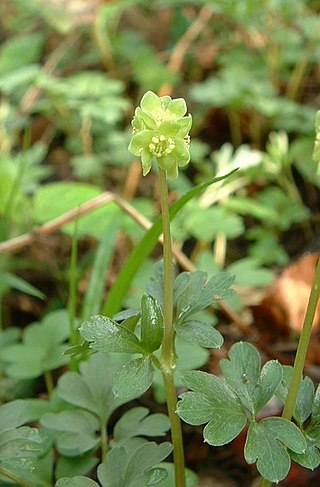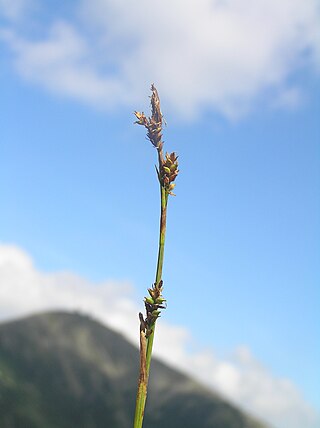
Adoxa moschatellina, moschatel, is a species of flowering plant in the family Adoxaceae which has a highly distinctive inflorescence. This herbaceous perennial grows in relatively sunny places in old woodland, such as the edges of streams, and in shady places in open habitats such as rock crevices in limestone pavements. It has a limited ability to spread by seed, but expands vegetatively via its long stolons. It is a widespread but generally uncommon plant which is not considered to be threatened within its natural range.

Chrysosplenium is a genus of 57 species of flowering plant in the family Saxifragaceae. Species can be found throughout the Arctic and northern temperate parts of the Northern Hemisphere, with the highest species diversity in eastern Asia; two species are found disjunctly in South America.
Eriophyllum latilobum, the San Mateo woolly sunflower, is a perennial herb of sharply limited range, endemic and occurring only in the state of California, United States. This flowering plant of the family Asteraceae has been listed as an endangered species by the U.S. federal government as well as the state of California.

Saxifraga paniculata is an alpine species of flowering plant in the saxifrage family, with native distribution in the temperate northern hemisphere. Common names include alpine saxifrage, encrusted saxifrage, lifelong saxifrage, lime-encrusted saxifrage, livelong saxifrage, white mountain saxifrage, and silver saxifrage.

Saxifraga stolonifera is a perennial flowering plant known by several common names, including creeping saxifrage, strawberry saxifrage, creeping rockfoil, Aaron's beard, mother of thousands, roving sailor, and strawberry begonia or strawberry geranium.

Lactuca canadensis is a species of wild lettuce known by the common names Canada lettuce, Canada wild lettuce, and tall lettuce. Its true native range is not clear, but it is considered to be a native of the eastern and central parts of North America. It naturalized in the western part of the continent as well as in Eurasia.

Mitella ovalis is a species of flowering plant in the saxifrage family known by the common names coastal miterwort and oval-leaf miterwort. It is native to western North America from southwestern British Columbia, including Vancouver Island, to northern California as far south as Marin County. It grows in moist, shady habitat, such as coastal forests and streambanks.

Montia chamissoi is a species of flowering plant in the family Montiaceae known by the common names of water minerslettuce, water montia, Indian lettuce, and toad lily. It is native to much of western North America from Alaska to the southwestern and central United States and also in British Columbia. It grows in moist to wet soils in a variety of habitat types, such as meadows, wetlands, plains, and montanes. It is sometimes aquatic, anchoring in mud and floating in water.

Lysimachia congestiflora, known as golden globes loosestrife or creeping Jenny, is a flowering plant species in the primrose family that native to southeast Asia.

Rubus pubescens is a herbaceous perennial widespread across much of Canada and the northern United States, from Alaska to Newfoundland, south as far as Oregon, Colorado, and West Virginia.

Minuartia cumberlandensis is a rare species of flowering plant in the pink family known by the common names Cumberland stitchwort and Cumberland sandwort. It is endemic to the Cumberland Plateau near the Big South Fork of the Cumberland River in Tennessee and Kentucky. This rare plant is found only in cool sandstone rock shelters, on the moist sandy cave floors behind the drip line. There are 27 occurrences in Tennessee and one in Kentucky. The plant is a federally listed endangered species.

Carex lutea is a rare species of sedge known by the common names golden sedge and sulphur sedge. It is endemic to North Carolina, where it is known only from Pender and Onslow Counties in the Cape Fear River watershed. There are nine populations. The plant was discovered in 1991 and described to science as a new species in 1994, and it has not been thoroughly studied nor completely surveyed yet. Its rarity was obvious by 2002, however, when it was federally listed as an endangered species.

Galearis rotundifolia is a species of flowering plants in the orchid family, Orchidaceae. It is commonly called roundleaf orchis and small round-leaved orchid. It is a succulent perennial herb native to North America, where it occurs throughout Canada, part of the northern United States, and Greenland.

Scirpus ancistrochaetus is a rare species of flowering plant in the sedge family known by the common names barbedbristle bulrush and northeastern bulrush. It is native to the northeastern United States from New Hampshire south to Virginia. It used to be found in Quebec but it is now thought to be extirpated there. It was also believed extirpated from the state of New York, but at least one population has been rediscovered in Steuben County in 2010. It is threatened by the loss and degradation of its wetland habitat. It is a federally listed endangered species.

Artemisia norvegica is a species of flowering plant in the aster family known by the common names alpine sagewort, boreal sagewort, mountain sagewort, Norwegian mugwort, arctic wormwood, and spruce wormwood. It is found in cold locations in Eurasia and high altitudes and high latitudes in North America.

Carex vaginata is a species of sedge known by the common name sheathed sedge.
Euphorbia purpurea is a species of Euphorbia known by the common names Darlington's glade spurge, glade spurge, and purple spurge. It is native to the Eastern United States, where it occurs from Ohio and Pennsylvania south to North Carolina. It has been extirpated from Alabama; it was believed lost from Delaware until a population was rediscovered in 1997.

Chrysosplenium wrightii, or Wright's golden saxifrage, is a plant species native to northwestern North America and northeastern Asia. It grows on tundra and along stream banks at elevations up to 2300 m in British Columbia, Yukon, Alaska, the Kamchatka Peninsula in Russia, and in eastern Siberia. The plant was first described in 1878 as being from Japan. This was based on material collected along the Sea of Okhotsk presumably either Sakhalin Island or one of the Kuril Islands, parts of Japan at the time but now in the Russian Federation.

Tiarella stolonifera is a species of flowering plant in the family Saxifragaceae. The specific name stolonifera means "spreading by stolons", an important characteristic of this species. Known as the creeping foamflower, it has the widest range of any species of Tiarella in eastern North America.



















